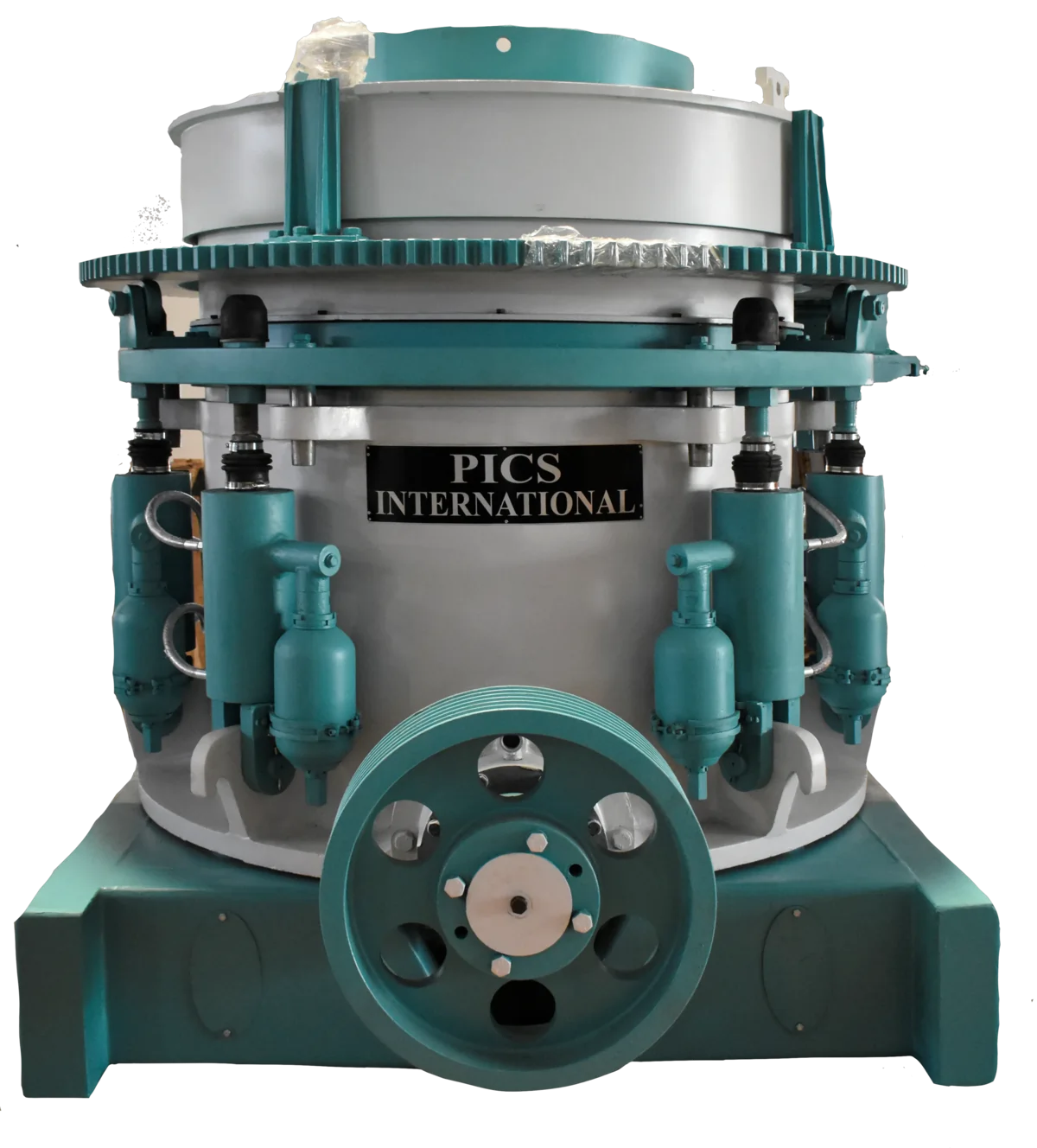Quick Links
Cone Crusher
Cone Crusher
PICS INTERNATIONAL introduces the latest technology Hydro Cone Crushers. PICS INTERNATIONAL cone crushers are suitable for a wide range of applications to get excellently shaped product in polyhydric shape.
There Are two type of cone crusher :-
FREQUENTLY ASKED QUESTIONS
FAQ
Cone crushers are common rock crushing equipment used in mining, recycling, and the manufacturing of aggregates. In secondary, tertiary, and quaternary crushing phases, they are typically employed.
A V-belt or direct drive is used to transfer power from the source to the countershaft. The countershaft drives the gear on the eccentric assembly using a bevel pinion that is pushed and keyed to it. The eccentric assembly, which has a tapered, off-centered bore, allows the head and main shaft to rotate in an eccentric manner during each cycle of rotation. After first crushing, cone crushers are utilised for secondary and fine crushing. The profile of the crushing chamber or cavity is the primary determinant of how well a cone type secondary crusher performs.
Cone crushers and jaw crushers both perform well in quarries, aggregates plants,
sand making plants, cement plants, etc. However, many still do not know which
one to choose.
To help you decide, now let's dive into the differences between cone crushers
and jaw crushers.
- Different production characteristics
- The overall structure of the machine
- Material handling
- Feeding requirements
- The shape of the finished product
- Maintenance cost
Feeding size:The cone crusher is quite tiny, often needing less than 450mm, but the jaw crusher has a reasonably wide range of feed sizes and can typically handle materials below 1,200mm (depending on the specific conditions of the product).
Discharging size: The Jaw crusher is typically used for first crushing, giving you a high crushing capacity and a larger output size that is still acceptable for subsequent crushing. Cone crushers, on the other hand, are used for intermediate and tertiary crushing stages and have a smaller discharge size.
Capacity:The output of the cone crusher can often exceed 2181t/h, which is much larger than the output of the jaw crusher in terms of processing capacity.
When compared to the jaw crusher with the same feeding opening size, the cone crusher is 1.7–2 times heavier and 2-3 times taller from the standpoint of the overall structure. Larger machines come at a larger expense for the location.
The jaw crusher can handle a wide range of materials with varying degrees of
hardness, including talc, limestone, chalcocite, hematite, pebbles, granite,
etc.
While the cone crusher is more suited for crushing hard rocks and ores like
pebbles, granite, and iron ore. In addition, viscous materials with a lot of
moisture should not be crushed in a cone crusher.
With a cone crusher, there is no need for feeders and silos since the
material may be fed straight into the machine until it is full.
When
using a jaw crusher, the material must be fed into the machine consistently
by a feeder, and it is not permitted to have more material within the
machine than can cover the top of the crushing chamber by 2/3 of its height.
Additional feeders and silos require more auxiliary equipment expenditure.
Cone crushers often produce products with higher cubic material contents than
jaw crushers do.
Therefore, the cone crusher may be utilised as the crushing equipment to
make concrete aggregates in cases where cubic particles are required, for
example, the anti-skid pavement of high-grade highways.
While in use, all equipment needs routine maintenance. Although the cone crusher is more expensive than the jaw crusher, its ongoing maintenance costs are lower because of the extended maintenance cycle made possible by the wear-resistant components and easy upkeep.
When choosing a hydrocone crusher, it is important to take into account all of the aforementioned variables, including feed size, capacity needs, product requirements, and operating circumstances. It makes perfect sense to use the smallest Hydrocone crusher for the work at hand. The size of the crusher must be chosen to account for expected wear of the main crusher's discharge setting if it is placed as a secondary crusher after a primary crusher. When making the first choice, consideration must be given to the closest setting that will be necessary if a range of items will be needed.
Due to its distinctive compact form, PICS INTERNATIONAL Cone may be readily installed to various kinds of stationary and mobile plants. This machine's advantages include a high crushing ratio, high efficiency, high handling capacity, low operational costs, simple adjustment, and cost-effective operation. In addition to lowering the circulation load, the quality of the materials used for the components and the sensible design of the construction contribute to the machine's longer operating performance and uniform granularity of the crushed output.
A remote reservoir system is used by cone crushers to deliver filtered and temperature-adjusted oil to the step bearing, eccentric bushing or bearing, main shaft and wear plates, upper bearings, and bevel gear and pinion on its return to the reservoir. EP/AS gear oil is often used to lubricate parts of the oil circuit.
The ratio of feed size to product size during a crushing process is known as the reduction ratio. The reduction ratio depends on the chamber and nut modifications, albeit it often fluctuates. However, material that is almost the same size as the CSS, the jaw crusher's smallest discharge opening diameter, is where the optimum particle form may be obtained.









